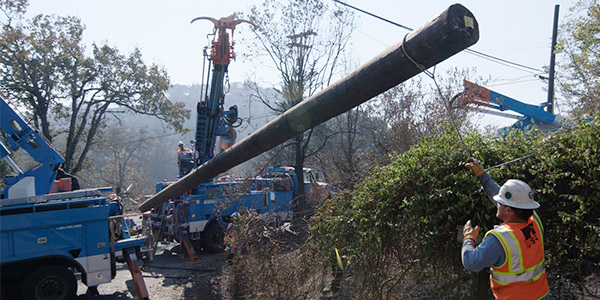The California Public Utilities Commission might implement, for the first time, the strict regimen of oversight and enforcement that Pacific Gas and Electric agreed to last year as part of its bankruptcy plan, the commission’s president told the utility last week.
The commission is concerned about alleged lapses in PG&E’s vegetation and line maintenance. The oversight process includes mechanisms that could eventually place PG&E into receivership or allow a public takeover of the utility.
“As you are aware, as a condition of approval of Pacific Gas and Electric Co.’s plan of reorganization, the California Public Utilities Commission instituted a six-step enhanced oversight and enforcement process to ensure PG&E is held accountable for delivering on its safety responsibilities,” CPUC President Marybel Batjer wrote to interim CEO William Smith on Tuesday. “By this letter, I am writing to inform you that I have directed CPUC staff to conduct fact-finding to determine whether a recommendation to place PG&E into the enhanced oversight and enforcement process is warranted. These fact-finding activities are well underway and are being undertaken expeditiously.
“My concerns arose from what appears to be a pattern of vegetation and asset management deficiencies that implicate PG&E’s ability to provide safe, reliable service to customers,” she continued. The CPUC’s Wildfire Safety Division “identified a volume and rate of defects in PG&E’s vegetation management that is notably higher than those observed” for the state’s other large investor-owned utilities. “In addition, CPUC staff are reviewing recent filings made by PG&E in its federal criminal proceeding regarding deficiencies and inconsistencies in its vegetation management practices and recordkeeping.”
PG&E did not immediately respond to a request for comment. It acknowledged in a federal court filing earlier this month that it needs to improve its vegetation maintenance practices.
‘Offender PG&E’
Gov. Gavin Newsom signed a bill in July that put the CPUC’s increased oversight-and-enforcement protocol into state law. (See Governor Signs PG&E ‘Plan B’ Takeover Bill.)
The rules require PG&E to submit to greater scrutiny and potential state control for repeated and uncorrected safety problems. Under the terms of the law, the CPUC can appoint a third-party monitor, followed by a receiver, and eventually rescind PG&E’s license to operate as the monopoly utility for most of Northern and Central California.
PG&E equipment caused catastrophic wildfires in 2017 and 2018 that killed more than 100 people and destroyed thousands of homes, resulting in its bankruptcy and stricter scrutiny by state and federal authorities.
The utility remains on probation for felonies related to the San Bruno gas pipeline explosion in 2010. U.S. District Judge William Alsup, who oversees the probation, has repeatedly required PG&E to account for its fire-prevention activities and, in some cases, its role in starting new fires. In October, Alsup questioned PG&E about its possible part in starting the Zogg Fire, which swept through rural Shasta and Tehama counties in late September, killing four residents and destroying more than 200 structures. (See PG&E Line Was Active when Zogg Fire Started.)
A federal monitor reporting to Alsup criticized PG&E’s vegetation management practices in an Oct. 16 letter.
“On a per-mile basis, the monitor team is finding more missed trees … in 2020 than we did in the later part of 2019,” it said. One reason could be that PG&E trimmed trees in areas with low fire risk in 2019 to meet its CPUC-approved targets, rather than trimming trees in the high-fire-risk areas, the monitor said.
Alsup ordered PG&E to explain its shortcomings, which the monitor attributed to “human error, lack of oversight, miscommunications and failure to appropriately escalate matters.” Those were the “same problems that offender PG&E has long had,” the judge said.
PG&E responded Nov. 3 that it “did not programmatically target low-risk line miles for work in its Enhanced Vegetation Management (EVM) program during 2019” but instead used a risk model along with other factors, including weather conditions, to schedule maintenance.
“By the end of 2019, approximately 40% of the miles completed and more than 50% of the trees worked (removed or trimmed) as a result of the EVM program were in the top 100 highest-risk circuits as identified by the risk model in use at the time.
“While those figures reflect a significant reduction in wildfire risk, PG&E also accepts and agrees with the monitor’s view that in making operational decisions, PG&E must give greater weight to working the riskiest areas first and must do so in a more rigorous, consistent and measurable way,” it said.





